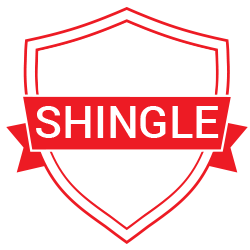Rubber Roofing, Made More Reliable Than Ever
When you need a new rubber roof on your home or business property, there’s no shortage of options, materials, and contractors to consider. No matter what kind of roofing service you need for your rubber roof, whether it’s a simple replacement of several tiles, or a complete removal and reinstallation of a new roofing system, you want to know that the contractor you ultimately go with is a reliable one.
At Elite Roofing, we’ve proudly provided homeowners and commercial properties throughout West Virginia and Pennsylvania with top-quality services for rubber roof tiles. From initial installations to renovations, repairs, and general maintenance, when you choose Elite as your go-to local roofer, you can be certain that you’ll get a valuable return on your property investment.
The contractors we select to join the Elite Roofing team are admitted because they have a history of positive reviews and high-quality performance ratings. Our roofing company uses top-of-the-line rubber roofing products and industry-recommended best practices for all clients and all services. If you’re seeking service for a roofing inspection or if you’re in need of a dependable local contractor with experience in rubber tile roof installations, you’re already in the right place. Contact our professional contractors at Elite Roofing to get a free quote today!

Why Consider Rubber Roofing?
As a roofing material, rubber has made a name for itself as one of the most cost-effective, energy-efficient, and long-lasting options available in today’s market. But what makes it ideal for homes in an Eastern region such as ours? Thanks to its heavy-duty structural components and design, virtually every form of rubber roofing material will be able to withstand the elements of our Appalachian environment. With dozens of appearance and style options to choose from, there’s a rubber roofing system for every kind of home and property.
In multiple long-term industry studies, research has determined that rubber slate roofing and rubber roofing tiles can outlast and outperform competing materials. With an average life expectancy of 15 to 30 years for most homes and buildings, rubber roofing exceeds industry standards in a number of areas — and it’s low maintenance, too!
So if you need a new roof for your property in West Virginia or Pennsylvania, Elite Roofing has the reliable team and quality roofing materials from industry-leading manufacturers. Even though these roofs may be made from rubber shingles and synthetics, we can say with confidence that these structures honestly won’t bounce. When you receive service from Elite Roofing, you can count on your rubber roof system to remain in great condition for many years, if not decades, to come!
Rubber Slate Roofing & Shingle Alternatives
You already know that rubber roofing is a smart investment and a dependable material that can hold up to the harsh climates of the Eastern U.S., but what else is there to know about the various types and options of this essential building material?
Many of our clients at Elite Roofing are surprised to learn that rubber makes a great alternative to many traditional forms of roofing materials, including asphalt shingles. Instead of the reflective shingles you may be familiar with, consider rubber shingles as a more durable, thermally efficient alternative. And because it’s made from rubber rather than fossil fuels, you’ll also have the benefit of knowing that any future repairs or replacements made to your shingle roof will be done with eco-friendly, renewable materials.
How Is Rubber Roofing Installed?
There are several methods that may be used to install a rubber roof, depending on the style of the roofing material itself — shingle, tile, flat, etc. — as well as the slope of the project structure’s roof. In properties and homes throughout West Virginia and Pennsylvania, Elite Roofing uses a standard process of installation for most new rubber roofs. Of course, each roofing system is independently assessed and individual characteristics are always taken into consideration, along with homeowner or property owner preferences and needs.
Our certified contractors most often install rubber roofs using one of two styles of the material: shingles, or rolls. In general, homes and residential sites in our service area will benefit the most from installation of a rubber roofing roll system. This is because the rolls of rubber are installed as large, single units, the vast majority of which are lower in cost than the combined units of a rubber shingle system.
After stripping any previously laid materials or roofing systems off of the project structure, our Elite roofers will then proceed to lay down the client’s selected form and style of rubber roofing. Whether a client prefers rubber rolls or rubber shingles is contingent upon budget and personal design taste, but the structure of a property itself can also be a determining factor. Older buildings usually cannot support as much weight as more recently built structures, and so may be better off with a lightweight roll of rubber roofing rather than attempting to accommodate the added weight burden of rubber shingles, nails, and connective components of the system.
The method of installation for a rubber roof — or any roofing system for that matter — is more critical than many individuals might realize or consider. Rubber roofs are not only lower in cost than many types of asphalt shingles, but they’re also lighter in weight than most alternatives. For this reason, the material can be installed on older buildings and homes — which means more properties and more people can reap the cost-effective, eco-friendly, and heavy-duty benefits of rubber roofing systems. high-durability rubber.





Get A Free Quote On Rubber Roofing Today!
Trusted and depended upon by clients throughout our xtensive service areas in West Virginia and Pennsylvania, Elite Roofing is the team to contact for any and all of your rubber roofing needs. You can read some of our top-rated client reviews to see why, or explore our other materials and service options by visiting our Roof Types resource page.
Across the greater part of Appalachia, we’re proud to be one of the leading roof companies with specialized expertise in rubber shingles, rubber roof repair, and so much more. Always efficient and equally affordable, please contact Elite Roofing today for a complimentary quote on your rubber roof project. Feel free to ask a question or two if you’d like. Don’t delay on superior roofing services — Contact us today!

Rubber Roofing, Done Right. Every Project, Every Project.
Contact Elite Roofing Today




